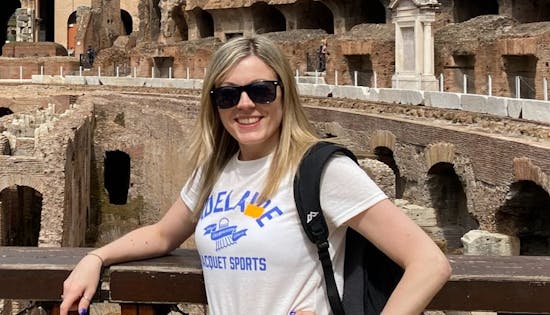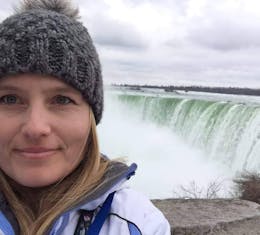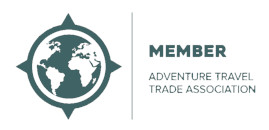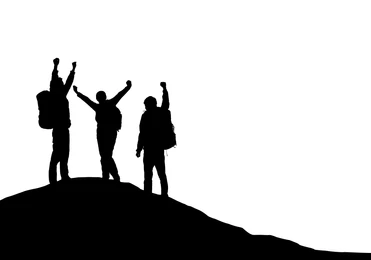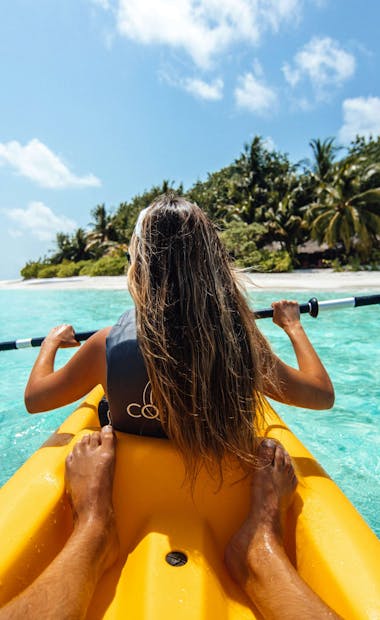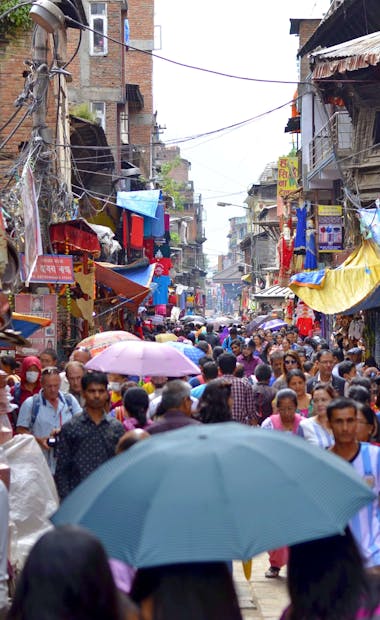
Nepal Tours
Challenge yourself trekking the Himalayas, discover wildlife and visit medieval temples
Popular tours
- Save14%
 View Tour
View TourEverest Base Camp Trek All Inclusive - 14 Days
- Kathmandu to Kathmandu
- Age group: 14 - 99
- Max group size: 12
Was:£1,435From£1,234 - Save16%
 View Tour
View TourNepal Snapshot - 7 Days
- Kathmandu to Kathmandu
- Age group: 18 - 39
- Max group size: 22
Was:£690From£580 - Save9%
 View Tour
View TourNepal Family Adventure – 14 Days
- Kathmandu to Kathmandu
- Age group: 7 - 99
- Max group size: 10
Was:£1,771From£1,612 - Save4%
 View Tour
View TourEverest Trek & Overnight at Base Camp - 17 Days
- Kathmandu to Kathmandu
- Age group: 18 - 99
- Max group size: 12
Was:£1,737From£1,675 - Save9%
 View Tour
View TourNepal Family Adventure -10 Days
- Kathmandu to Kathmandu
- Age group: 7 - 99
- Max group size: 10
Was:£1,652From£1,504 - Save9%
 View Tour
View TourWomen's Everest Base Camp Trek (Inc Food) - 14 Days
- Kathmandu to Kathmandu
- Age group: 18 - 80
- Max group size: 10
Was:£1,366From£1,242
Nepal Tours
Welcome to the enchanting land of Nepal, a mesmerising country nestled in the lap of the mighty Himalayas. Known as the land of the world's highest peak, Mount Everest, Nepal is a haven for adventure enthusiasts and nature lovers alike. As you embark on your journey through this captivating nation with our specialised travel agency, get ready to experience a tapestry of awe-inspiring landscapes, rich cultural heritage, and adrenaline-pumping treks that will leave you spellbound.
For those seeking a truly unique and exhilarating experience, our Nepal tours offer a range of options that cater to all interests and fitness levels. One of the crown jewels of our itinerary is the iconic Everest Base Camp Trek, a dream come true for avid trekkers and mountaineering enthusiasts. This legendary expedition takes you through breathtaking valleys, picturesque Sherpa villages, and challenging mountain trails, ultimately leading you to the base camp of the highest peak on Earth. Standing at the foot of Mount Everest, you'll be awe-struck by its majestic presence and humbled by the indomitable spirit of the climbers who dare to conquer it.
But Nepal has so much more to offer beyond the Everest Base Camp Trek. Immerse yourself in the vibrant streets of Kathmandu, the bustling capital city that effortlessly blends ancient traditions with modern developments. Lose yourself in the narrow alleys of Durbar Square, a UNESCO World Heritage site, where you can marvel at intricately carved temples and ancient palaces that showcase the architectural grandeur of Nepal's history.
For a spiritual awakening, journey to the birthplace of Gautama Buddha in Lumbini, a pilgrimage site that attracts Buddhist devotees from around the globe. Explore the tranquil monasteries, meditate in the peaceful gardens, and gain a deeper understanding of Buddhism's profound teachings.
Nature lovers will be captivated by the ethereal beauty of Pokhara, a picturesque lakeside city nestled amidst snow-capped peaks and verdant valleys. Take a serene boat ride on Phewa Lake, surrounded by the reflection of the majestic Annapurna Range, or embark on a thrilling paragliding adventure to soak in the panoramic views of this idyllic landscape.
If wildlife fascinates you, a visit to Chitwan National Park is a must. Embark on an exhilarating jungle safari to spot rare species like the one-horned rhinoceros and elusive Bengal tigers. Immerse yourself in the lush greenery, listen to the symphony of exotic birds, and witness nature's raw beauty unfold before your eyes.
Nepal truly has something for everyone, from adrenaline-pumping treks to serene cultural experiences. Let our experienced guides and local experts accompany you on this incredible journey, ensuring your safety, comfort, and an authentic immersion into the heart and soul of Nepal. Join us for an unforgettable adventure as we create memories that will last a lifetime.
Embark on our Nepal tours and discover the wonders of this enchanting land, where the breathtaking landscapes will leave you awestruck and the warm hospitality of the Nepalese people will touch your heart. Get ready to explore the Everest Base Camp Trek and beyond, as you delve into the treasures of Nepal's natural and cultural heritage.
When is the best time to visit Nepal?
The best time to visit Nepal largely depends on the activities you wish to engage in and the regions you plan to explore. Nepal experiences a diverse climate due to its varying topography, ranging from the subtropical plains of Terai to the snow-covered peaks of the Himalayas. However, there are two main seasons that are often considered the ideal time for travelers:
Autumn (September to November): This season is widely regarded as the best time to visit Nepal. The weather is generally stable, with clear skies, mild temperatures, and low chances of rainfall. The lush greenery of the countryside is complemented by the vibrant colors of blooming flowers, making it a visually stunning time to explore the landscapes. Autumn is also the peak trekking season, including the popular Everest Base Camp Trek, as the trails are dry and offer excellent visibility of the majestic mountains.
Spring (March to May): Another favorable time to visit Nepal is during spring. The weather remains pleasant, with moderate temperatures and occasional showers. The hills and mountains come alive with blossoming rhododendrons and other wildflowers, creating a picturesque setting. Spring is also a great time for trekking, as the trails are adorned with colorful flora. Additionally, the valleys and plains of Nepal showcase their vibrant agricultural activities during this season.
It's important to note that Nepal can still be visited during other times of the year, but the weather conditions and accessibility to certain regions may vary. For instance, the summer months (June to August) bring monsoon rains, which can result in muddy trails and limited mountain views. However, this time is perfect for exploring the lush greenery and enjoying cultural experiences in the Kathmandu Valley and other lower-altitude regions.
Ultimately, the best time to visit Nepal depends on your preferences, whether it's trekking, wildlife safaris, cultural exploration, or simply enjoying the beauty of nature. Consulting with your travel agency or doing further research on specific activities and regions will help you determine the optimal time for your visit.
Will I require a visa to visit Nepal?
Yes, most visitors to Nepal require a visa to enter the country. However, the specific visa requirements can vary depending on your nationality and the purpose of your visit. Here is some general information about the visa process for Nepal:
Tourist Visa: If you are planning a holiday or tourism-related activities in Nepal, you will typically need a Tourist Visa. This visa allows you to stay in Nepal for a specific duration for leisure purposes, such as trekking, sightseeing, or cultural exploration. Tourist Visas can be obtained upon arrival at Tribhuvan International Airport in Kathmandu or at various land border crossings. The duration and fees for the visa will depend on the length of your stay, ranging from 15, 30, to 90 days.
Visa Extension: If you wish to extend your stay beyond the initial duration granted by your Tourist Visa, you can apply for a visa extension at the Department of Immigration in Kathmandu or at certain immigration offices in Nepal. It is advisable to start the extension process before your visa expires to avoid any complications.
Visa Requirements: To apply for a Tourist Visa, you will typically need the following documents:
- A valid passport with at least six months of validity from the date of entry.
- A completed visa application form (available at the immigration counter or online).
- Recent passport-sized photographs as per the specifications.
- Visa fees in the form of cash (USD or local currency) or other accepted payment methods.
- For some nationalities, additional documentation such as a return ticket or proof of hotel reservations may be required. It is advisable to check with the Nepalese embassy or consulate in your home country for specific requirements.
Please note that visa regulations can change, so it is always a good idea to check the latest information from the official website of the Department of Immigration of Nepal or consult with the Nepalese embassy or consulate in your country before your trip. This will ensure that you have the most up-to-date and accurate information regarding visa requirements for your specific nationality and purpose of visit.
What are the main attractions when visiting Nepal?
When visiting Nepal, you will be immersed in a plethora of captivating attractions that cater to a wide range of interests. Here are some of the main attractions that await you in this enchanting country:
Kathmandu Valley: The Kathmandu Valley is a treasure trove of cultural and historical wonders. Explore the UNESCO World Heritage Sites of Kathmandu Durbar Square, Patan Durbar Square, and Bhaktapur Durbar Square, where ancient palaces, intricate temples, and beautifully carved architecture transport you back in time. The holy pilgrimage site of Swayambhunath, also known as the Monkey Temple, offers panoramic views of the city and a tranquil spiritual experience.
Trekking in the Himalayas: Nepal is renowned for its breathtaking trekking routes, offering an adventure of a lifetime. The Everest Base Camp Trek, Annapurna Circuit, Langtang Valley Trek, and many others cater to different levels of fitness and provide opportunities to witness awe-inspiring landscapes, remote mountain villages, and the majestic Himalayan peaks.
Chitwan National Park: Embark on a thrilling wildlife safari in Chitwan National Park, a UNESCO World Heritage Site. This tropical jungle sanctuary is home to diverse wildlife, including the rare one-horned rhinoceros, Bengal tigers, elephants, and a wide variety of bird species. Explore the park on an elephant-back safari, a jeep safari, or a guided nature walk to witness the rich biodiversity up close.
Pokhara: Nestled beside the serene Phewa Lake and surrounded by the Annapurna Range, Pokhara is a haven for nature lovers. Take a boat ride on the lake, enjoy the reflection of the mountains, and visit the peaceful Bindabasini Temple. Adventure seekers can indulge in paragliding, zip-lining, or canyoning for an adrenaline rush. The nearby Sarangkot viewpoint offers breathtaking sunrise and sunset vistas.
Lumbini: Pay homage to the birthplace of Gautama Buddha in Lumbini, a sacred pilgrimage site for Buddhists worldwide. Explore the Maya Devi Temple, the Ashoka Pillar, and various monasteries and meditation centers that provide a serene atmosphere for spiritual reflection.
Annapurna Region: The Annapurna region offers not only trekking opportunities but also stunning natural beauty. Enjoy the picturesque landscapes, lush forests, cascading waterfalls, and traditional Gurung and Magar villages. The Annapurna Base Camp Trek and the Ghorepani Poon Hill Trek are popular choices in this region.
Nagarkot: For breathtaking panoramic views of the Himalayan range, visit Nagarkot, a hill station located just outside Kathmandu. Wake up early to witness a magical sunrise over the snow-capped peaks, including Mount Everest on a clear day.
These are just a few highlights of the myriad attractions Nepal has to offer. From cultural heritage sites to thrilling adventures and serene natural beauty, Nepal is a destination that will leave you captivated and longing for more.
Is Nepal a safe destination?
Nepal is generally considered a safe destination for travelers. The country has made significant progress in terms of safety and security in recent years. However, as with any travel destination, it's important to exercise caution and take certain precautions to ensure a safe and enjoyable trip. Here are some points to consider:
Personal Safety: Nepal is known for its warm and welcoming hospitality, and incidents of violent crime against tourists are rare. However, it's always advisable to take common-sense precautions such as being aware of your surroundings, avoiding isolated areas at night, and keeping your belongings secure.
Altitude Sickness: When engaging in activities like trekking in the higher altitudes of the Himalayas, there is a risk of altitude sickness. It's crucial to acclimatize properly, drink plenty of water, and listen to your body. It's recommended to trek with experienced guides who are knowledgeable about altitude-related issues.
Trekking Safety: If you're planning on trekking in Nepal, it's important to choose a reputable trekking agency that provides experienced guides, proper equipment, and adheres to safety protocols. Registering your trek with the local authorities and obtaining appropriate permits is also essential.
Natural Hazards: Nepal is prone to natural hazards such as earthquakes, landslides, and avalanches due to its location in a seismically active region. It's advisable to stay informed about weather conditions, follow safety guidelines, and heed advice from local authorities and trekking agencies.
Political Situation: Nepal has undergone significant political changes in recent years, and the country is generally politically stable. However, it's advisable to stay updated on any political developments and follow local news sources or travel advisories issued by your home country.
Health Precautions: Like in any foreign country, it's recommended to take necessary health precautions before visiting Nepal. Consult with a healthcare professional or travel clinic to get up-to-date information about vaccinations and any specific health concerns.
It's always a good idea to have comprehensive travel insurance that covers medical expenses, trip cancellations, and other unforeseen circumstances.
By staying informed, taking necessary precautions, and using common sense, you can have a safe and memorable experience in Nepal. It's also helpful to consult with your travel agency or check the latest travel advisories from your home country's government before planning your trip.
What is the local currency in Nepal, and can I use credit cards?
The local currency of Nepal is the Nepalese Rupee (NPR). When visiting Nepal, it is advisable to carry some amount of local currency for small purchases, transportation, and other expenses in areas where credit cards may not be widely accepted.
Credit cards are accepted in many hotels, larger restaurants, and shops in major tourist areas of Nepal, particularly in Kathmandu and Pokhara. However, it's important to note that credit card acceptance may be limited in more remote or rural areas, smaller establishments, and local markets. Therefore, it is always wise to have some cash on hand for these situations.
ATMs are widely available in urban areas, and most accept international debit and credit cards for cash withdrawals. However, it is advisable to inform your bank or card issuer about your travel plans to Nepal to ensure that your card will work abroad and to inquire about any applicable fees or restrictions.
It's also recommended to carry small denominations of the Nepalese Rupee for easier transactions, as smaller establishments and vendors may not always have change for larger bills.
For major expenses such as trekking permits, national park fees, or higher-end hotels, it is common to make payments in cash, preferably in Nepalese Rupees.
Overall, a combination of cash and credit cards will ensure flexibility and convenience during your visit to Nepal.
Will I require any vaccinations to travel to Nepal?
Yes, it is recommended to have certain vaccinations before traveling to Nepal. The specific vaccinations you may need can depend on various factors, including your previous immunization history, current health status, the duration of your stay, and the areas you plan to visit within Nepal. It's important to consult with a healthcare professional or a travel clinic at least 4-6 weeks before your trip to get personalized advice based on your individual circumstances. However, here are some common vaccinations and health considerations for travel to Nepal:
Routine Vaccinations: Ensure that your routine vaccinations, such as measles-mumps-rubella (MMR), diphtheria-tetanus-pertussis, varicella (chickenpox), polio, and influenza, are up to date.
Hepatitis A and Typhoid: Both Hepatitis A and Typhoid are recommended for travelers to Nepal, as these diseases can be contracted through contaminated food and water.
Hepatitis B: Hepatitis B vaccination is advised for long-term travelers or those who may have close contact with local residents, especially in medical or healthcare settings.
Rabies: Depending on your planned activities and proximity to wildlife, such as trekking or working with animals, pre-exposure vaccination for rabies may be recommended. However, it's important to note that even with vaccination, immediate medical attention is required if you are bitten or scratched by an animal.
Japanese Encephalitis: Japanese Encephalitis vaccination may be recommended if you plan to visit rural areas of Nepal, particularly during the monsoon season, when the risk of mosquito-borne diseases is higher.
Malaria: The risk of malaria in Nepal is generally low, particularly in popular tourist areas at higher altitudes. However, in some low-lying regions, such as the Terai plains bordering India, there may be a risk of malaria. Consult with a healthcare professional for personalized advice on malaria prevention measures, such as antimalarial medication, based on your itinerary.
Remember, vaccination requirements can change, and it's important to keep up with the latest recommendations from reputable sources, such as the World Health Organization (WHO) or the Centers for Disease Control and Prevention (CDC). Additionally, take precautions to prevent mosquito bites, practice safe food and water hygiene, and consider travel insurance that covers medical emergencies during your trip.
What is best practice for tipping in Nepal?
Tipping in Nepal is not mandatory, but it is appreciated and customary in certain situations as a gesture of gratitude for good service. Here are some general guidelines for tipping in Nepal:
Hotels: It is common to tip hotel staff, including bellhops or porters who assist with carrying your luggage to your room. A tip of around 50-100 Nepalese Rupees per bag is considered appropriate.
Restaurants: Many restaurants in tourist areas may include a service charge on the bill. If a service charge is not included, a tip of around 5-10% of the total bill is appreciated for good service. However, tipping in local eateries or small cafes is not expected.
Trekking Guides and Porters: If you are undertaking a trekking or hiking adventure in Nepal and have hired a guide and/or porters, it is customary to tip them as they provide essential assistance throughout your journey. The amount can vary depending on the length and difficulty of the trek, as well as the level of service provided. As a general guideline, for guides, a tip of around USD 10-20 per day is customary, while for porters, around USD 5-10 per day is typical. However, these amounts can be adjusted based on your satisfaction and the size of your group.
Drivers and Guides: If you have hired a driver or a tour guide for your sightseeing or transportation needs, tipping is appreciated. For drivers, a tip of around 200-500 Nepalese Rupees per day is typical, while for guides, a tip of around 500-1000 Nepalese Rupees per day is customary.
Other Services: Tipping is not expected for everyday services such as taxi rides or small purchases. However, if someone provides exceptional service or goes above and beyond, you can offer a small tip as a token of appreciation.
Remember that these are general guidelines, and tipping amounts can vary based on personal preference, the level of service received, and your budget. It's important to consider the local standards and the economic conditions of the country while tipping. If you are unsure about tipping practices in specific situations, you can inquire with your travel agency or local guides for guidance.
Lastly, when giving a tip, it's best to hand it directly to the person rather than leaving it on a table or in a common tip jar to ensure that it reaches the intended recipient.
What is the food like in Nepal?
Nepalese cuisine is a delightful blend of flavors, influenced by its geography, culture, and neighboring countries. The food in Nepal offers a diverse range of dishes that will satisfy both meat lovers and vegetarians. Here are some highlights of Nepalese cuisine:
Dal Bhat: Considered the national dish of Nepal, Dal Bhat is a staple in Nepalese households. It consists of lentil soup (dal), served with steamed rice (bhat), and accompanied by a variety of side dishes such as vegetable curry (tarkari), pickles (achar), and sometimes meat or fish.
Momos: Nepalese dumplings, known as momos, are a popular street food and a favorite among locals and tourists alike. These delicious steamed or fried dumplings are typically filled with minced meat (chicken, buffalo, or pork), vegetables, or cheese, and served with a spicy dipping sauce.
Newari Cuisine: Newari cuisine, prevalent in the Kathmandu Valley, offers a rich culinary experience. Must-try dishes include Newari-style buff (water buffalo) choila, bara (fried lentil pancake), and kwati (a mixed bean soup). Another famous Newari dish is the mouthwatering samay baji, a platter of beaten rice, fried soybeans, boiled eggs, spicy potatoes, and various condiments.
Thakali Cuisine: Originating from the Thakali community in the Mustang region, Thakali cuisine is known for its distinct flavors. Thakali thali, a platter consisting of various items such as rice, lentils, meat curry, pickles, and fried greens, is a popular dish among locals and tourists alike.
Street Food: Nepal offers a wide array of street food options that are affordable and delicious. From spicy chaats (savory snacks) like pani puri and sev puri to popular snacks like sel roti (a sweet, crispy rice bread) and chatamari (a rice flour crepe topped with various ingredients), the street food scene in Nepal is vibrant and flavorsome.
Dhindo: Dhindo is a traditional Nepalese food made from corn, millet, or buckwheat flour. It has a porridge-like consistency and is often eaten with gundruk (fermented leafy greens) or vegetables.
Choyela: Choyela is a marinated and grilled meat dish, typically made with chicken or buffalo. It is seasoned with various spices, ginger, garlic, and mustard oil, giving it a distinct flavor.
Nepalese cuisine also offers a variety of vegetarian and vegan options, with lentils, vegetables, and dairy products playing a prominent role. Rice, wheat, and corn are staple grains, and spices such as cumin, coriander, turmeric, and chili are commonly used.
Don't forget to savor traditional Nepalese beverages like chiya (sweet milk tea), lassi (yogurt-based drink), and tongba (a fermented millet drink) during your culinary exploration.
Whether you're dining at a local eatery, enjoying street food, or trying dishes in upscale restaurants, the food in Nepal promises to be a delightful and flavorful experience, offering a glimpse into the rich culinary heritage of the country.
Can I drink the tap water in Nepal?
No, it is generally not recommended to drink tap water in Nepal. The tap water in Nepal is not considered safe for drinking due to the potential presence of bacteria, parasites, and other contaminants that can cause waterborne diseases.
To ensure safe drinking water during your stay in Nepal, consider the following options:
Bottled Water: The most convenient and widely available option is to drink bottled water. You can purchase sealed bottled water from reputable brands in grocery stores, hotels, and restaurants. Look for water brands that are popular and have intact seals.
Filtered and Purified Water: If you prefer to reduce plastic waste, you can use water purification methods to make tap water safe for drinking. Boiling water for at least three minutes is an effective way to kill most harmful bacteria and parasites. Alternatively, you can use water filters, purifiers, or water sterilization tablets that are specifically designed for travel purposes. These methods help remove or kill pathogens and make the water safe to consume.
Water Sterilization: Another option is to use water sterilization devices such as UV water purifiers or water sterilization pens. These devices use ultraviolet light to kill microorganisms in the water, making it safe to drink. Follow the manufacturer's instructions for proper usage.
Reusable Water Bottles: Consider carrying a reusable water bottle with you and refilling it with safe drinking water from trusted sources such as filtered or purified water dispensers available in hotels, restaurants, or shops.
It's important to avoid consuming ice cubes or using tap water for brushing your teeth. Stick to safe drinking water practices to prevent any potential waterborne illnesses during your visit to Nepal.
By taking these precautions, you can ensure that you stay hydrated and maintain good health throughout your trip.
Are there any cultural norms in Nepal I should follow?
Yes, Nepal has its own unique cultural norms and traditions, and it's important to be mindful of them as a visitor. Respecting the local culture helps create a positive and meaningful experience for both you and the Nepalese people. Here are some cultural norms to keep in mind when in Nepal:
Greetings and Respect: Nepalese people value politeness and respect. When meeting someone, it is customary to greet them with "Namaste" (pronounced na-ma-stay), accompanied by a slight bow or placing your palms together in a prayer-like gesture. This is a common form of greeting and shows respect. Addressing someone as "Dai" (brother), "Didi" (elder sister), "Bhai" (sir), or "Bahini" (madam) is also considered respectful.
Dress Modestly: While Nepal is becoming more cosmopolitan, particularly in urban areas, it is respectful to dress modestly, especially when visiting religious sites, monasteries, or rural areas. Avoid wearing revealing or skimpy clothing, and opt for conservative attire that covers your shoulders, chest, and legs.
Removing Shoes: It is customary to remove your shoes before entering someone's home, religious sites, and certain public places. Look for signs or observe if others are removing their shoes, and follow suit.
Etiquette in Temples and Monasteries: When visiting temples and monasteries, be respectful of the sacred space. Avoid taking photographs inside the prayer halls unless explicitly permitted. Follow any rules or instructions given by the caretakers or priests.
Interacting with Elders: In Nepalese culture, respecting and honoring elders is highly valued. When conversing with older individuals, use appropriate titles like "Dai" (brother), "Didi" (elder sister), "Uncle," or "Auntie" to show respect.
Public Displays of Affection: Public displays of affection, such as kissing or hugging, are not common in Nepalese culture and may be considered inappropriate. It is best to show affection towards your partner or loved ones in a more private setting.
Photography Etiquette: Always ask for permission before taking someone's photograph, especially when photographing locals or religious figures. Some places may have specific guidelines regarding photography, so it's important to respect any restrictions.
Use of the Right Hand: In Nepalese culture, the left hand is considered unclean, so it is polite to use your right hand for activities like eating, passing items, giving and receiving money, or shaking hands.
Religious Sensitivity: Nepal is a predominantly Hindu country, with a significant Buddhist population. Be mindful of religious customs and practices. Do not disturb or disrespect religious objects or rituals, and always seek permission before entering religious spaces.
Environmental Respect: Nepal's natural beauty is a treasure, and it's important to be responsible and respectful towards the environment. Avoid littering, and dispose of waste properly. Respect any wildlife conservation efforts and follow guidelines in national parks and protected areas.
By being aware of and practicing these cultural norms, you can show respect for the local customs and traditions, and enhance your interactions and experiences during your visit to Nepal.
What should I pack for my trip to Nepal?
When packing for your trip to Nepal, it's important to consider the diverse landscapes, weather conditions, and activities you'll be engaging in. Here's a list of essential items to pack for your Nepal adventure:
Clothing:
- Comfortable walking/hiking shoes: Choose sturdy, well-fitting shoes suitable for trekking or walking on uneven terrain.
- Lightweight and breathable clothing: Pack a mix of short-sleeved and long-sleeved shirts, pants, and shorts made of moisture-wicking fabric.
- Warm layers: Nights and higher altitudes can get chilly, so pack a fleece jacket, down or synthetic insulation, and thermal base layers.
- Rain gear: Carry a lightweight, waterproof jacket or poncho to stay dry during monsoon season or unexpected showers.
- Hat and sunglasses: Protect yourself from the sun with a wide-brimmed hat and sunglasses.
- Swimwear: If you plan to visit hot springs or enjoy water activities, pack swimwear.
Trekking Gear:
- Daypack: A sturdy backpack for day hikes and carrying essentials.
- Trekking poles: Optional but helpful for stability and reducing strain during treks.
- Sleeping bag: If you're planning multi-day treks or staying in teahouses, a lightweight sleeping bag is essential.
- Headlamp/Flashlight: Useful for trekking and during power outages.
- Quick-dry towel: Lightweight and compact for drying off after showers or trekking.
Miscellaneous Items:
- Travel adapter: Nepal uses Type C, D, and M power sockets, so bring an adapter if necessary.
- First aid kit: Include essential medications, band-aids, antiseptic cream, and any personal medical supplies.
- Personal toiletries: Carry a small toiletry kit with travel-sized products, including toilet paper and hand sanitizer.
- Sunscreen and insect repellent: Protect yourself from the sun and insects.
- Water bottle: Carry a reusable water bottle to minimize plastic waste.
- Snacks: Pack some energy bars or snacks for long journeys or trekking.
- Cash and cards: Have enough local currency (Nepalese Rupees) for smaller establishments and carry a credit/debit card as a backup.
Travel Documents:
- Passport: Ensure your passport is valid for at least six months beyond your planned departure date.
- Visa: Obtain a valid visa for Nepal before your trip.
- Travel insurance: It is highly recommended to have travel insurance that covers medical emergencies, trip cancellations, and evacuations.
- Photocopies: Carry photocopies of important documents like your passport, visa, travel insurance, and emergency contact information.
- Trekking permits: If you plan to trek in restricted areas, obtain the necessary trekking permits in advance.
Remember to pack according to the season and activities you have planned. Layering your clothing is recommended to adjust to varying temperatures. Pack light but essential items to make your travel more comfortable. And don't forget to leave some space in your bag for souvenirs and treasures you may find along the way.
What are the top ten treks in Nepal ?
Nepal offers a plethora of breathtaking treks that cater to all levels of experience and fitness. Here are ten of the top treks in Nepal, known for their scenic beauty, cultural significance, and adventure:
Everest Base Camp Trek: A classic and iconic trek that takes you to the base camp of Mount Everest, offering spectacular views of the world's highest peak.
Annapurna Circuit Trek: One of the most diverse and popular treks in Nepal, encircling the Annapurna Massif and crossing the Thorong La Pass. It showcases stunning landscapes, charming villages, and diverse cultures.
Langtang Valley Trek: A beautiful trek close to Kathmandu, offering a mix of alpine forests, glacial lakes, and impressive mountain vistas. It also provides an opportunity to explore the unique Tamang culture.
Manaslu Circuit Trek: A challenging trek that circumnavigates Mount Manaslu, the eighth highest peak in the world. It provides a glimpse into remote Himalayan villages and stunning landscapes.
Upper Mustang Trek: An ancient and culturally rich trek to the forbidden kingdom of Mustang. It takes you through arid landscapes, dramatic cliffs, and ancient Tibetan Buddhist monasteries.
Gokyo Lakes Trek: This trek leads you to the mesmerizing Gokyo Lakes in the Everest region, offering stunning views of mountains, glaciers, and turquoise lakes. It also includes an ascent of Gokyo Ri for panoramic vistas.
Kanchenjunga Base Camp Trek: A remote and challenging trek in eastern Nepal, it takes you to the base camp of Mount Kanchenjunga, the third highest peak in the world. It offers pristine landscapes and rich biodiversity.
Makalu Base Camp Trek: A less frequented but rewarding trek that leads to the base camp of Mount Makalu, the fifth highest peak. It showcases diverse ecosystems, deep gorges, and close-up views of towering peaks.
Dhaulagiri Circuit Trek: A challenging and less crowded trek that encircles Mount Dhaulagiri, the seventh highest peak. It traverses through remote valleys, glacier fields, and high passes.
Upper Dolpo Trek: A remote and culturally rich trek in the far-western region of Nepal, it explores the stunning landscapes of Dolpo, ancient Tibetan Buddhist monasteries, and the pristine Phoksundo Lake.
These treks vary in difficulty and require different levels of preparation, permits, and trekking experience. It's important to research and choose a trek that matches your fitness level, interests, and the time you have available.
How does the rooming work on tours?
Small group tours in Nepal typically involve a set itinerary where you travel with a group of fellow travellers and a tour leader/guide. Accommodation arrangements vary depending on the specific tour you choose. Here are some common aspects of rooming arrangements on small group tours:
Shared Rooms: In order to promote camaraderie and facilitate interaction among group members, most tours arrange shared accommodation. This means you will be paired with another member of the same gender from the group to share a room. Roommates may sometimes change periodically throughout the tour.
Single Supplement: If you prefer to have your own room and privacy, you may have the option to pay a single supplement fee. This additional fee allows you to have your own room for the duration of the tour. However, please note that single supplements can vary in cost and availability.
Roommate Matching: Tour operators usually offer roommate matching services, where they try to pair you with a suitable roommate based on your preferences, such as age range. This can help ensure compatibility and a more enjoyable experience for all participants.
Rooming Preferences: When booking your small group tour, it's important to communicate your rooming preferences to the tour operator. If you have specific requirements or preferences, such as sharing with a friend or a specific roommate request, it's advisable to inform the tour operator during the booking process.
It's important to carefully read the tour details and inclusions provided by the tour operator to understand their specific rooming policies. If having your own room is a priority, make sure to inquire about the availability of single supplements and any associated costs before booking your tour.
Keep in mind that while sharing a room with a fellow traveller can be a great way to meet new people and build connections, having your own room provides more privacy and flexibility. Consider your preferences and the dynamics of the tour when deciding whether to opt for a shared room or pay for a single supplement.
Remember to communicate your needs and preferences clearly with the tour operator during the booking process to ensure a comfortable and enjoyable accommodation experience on your small group tour in Nepal.
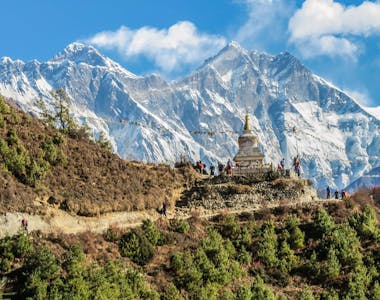
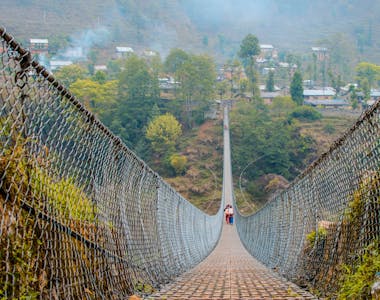
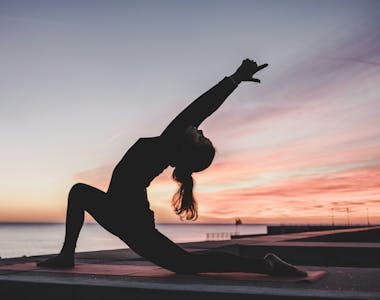
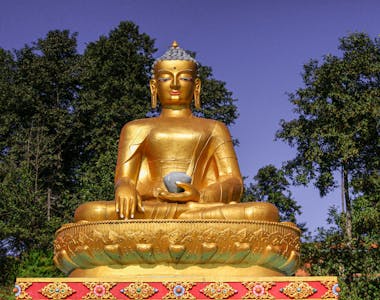
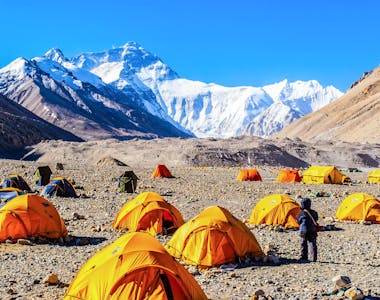

Book With Confidence
Monthly Payments
Spread the costs with no interest or additional fees
Best Price Guarantee
We won't be beaten on price. If you find this adventure at a lower price please get in touch!
Reserve now & pay later
Reserve your adventure today and pay later, free of charge
ATOL protected
Book with confidence
Hold your space today, for free
or book your trip with a deposit and then pay the rest in instalments.
Reserve your flights with us
Add flights to your booking and we'll take care of the rest. You'll get 24/7 support from our team & ATOL protection.
Speak to our experts
Call or email our expert team to find out more and help with ideas and planning.
